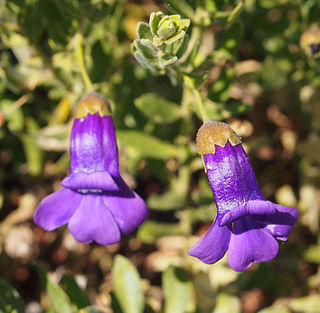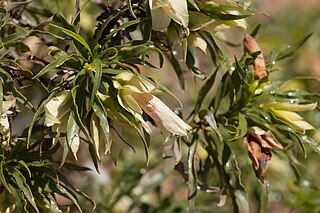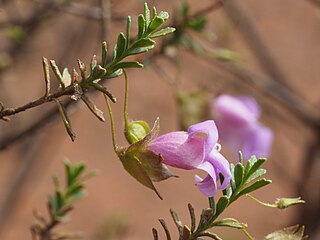
Eremophila oppositifolia, commonly known as weeooka, twin-leaf emu bush and mountain sandalwood, is a plant in the figwort family, Scrophulariaceae, and is endemic to Australia. It is a shrub or small tree with its leaves arranged in opposite pairs and has cream to red or sometimes maroon coloured flowers. It occurs in all mainland states, but not the Northern Territory.

Eremophila bowmanii, also known as silver turkeybush, Bowman's poverty bush and flannel bush, is a flowering plant in the figwort family, Scrophulariaceae and is endemic to New South Wales and Queensland in Australia. It is a low to medium, spreading shrub with silvery-grey, hairy foliage and blue to lilac flowers, and sometimes grows in dense thickets with mulga.

Eremophila macdonnellii, also known as MacDonnell's desert fuchsia, is a flowering plant in the figwort family, Scrophulariaceae and is endemic to Australia. It is a shrub with many tangled branches, which, along with the leaves, are often covered with many, sometimes long hairs. The flowers are deep violet or purple, and the species is widespread in Central Australia.
Eremophila acrida is a plant in the figwort family, Scrophulariaceae and is endemic to arid areas in the Northern Territory and Queensland in Australia. It is a small shrub with most of its above-ground parts covered with hairs which are tipped with a tiny yellow gland. It has a strong, bitter odour.

Eremophila alatisepala is a plant in the figwort family, Scrophulariaceae and is endemic to the south-west of Queensland in Australia. It is a very sticky shrub covered with many glandular hairs which produce a resin that often obscures the hairs that produce it. The plant is usually found in stony places on ridges and slopes in the Queensland Channel Country.

Eremophila enata is a flowering plant in the figwort family, Scrophulariaceae and is endemic to central areas of Western Australia. It is a low, spreading shrub with serrated leaves and purplish to pinkish flowers.

Eremophila flabellata is a flowering plant in the figwort family, Scrophulariaceae and is endemic to Western Australia. It is a small shrub with serrated leaves, broad serrated sepals and pink, purple or mauve flowers.

Eremophila foliosissima, commonly known as poverty bush, is a flowering plant in the figwort family, Scrophulariaceae and is endemic to Western Australia. It is a small, erect, densely foliaged shrub with long, narrow, hairy leaves and mauve to purple flowers. It is similar to Eremophila gilesii but is more dense and rounded, has more crowded leaves and has different hairs on the flowers.
Eremophila hispida is a flowering plant in the figwort family, Scrophulariaceae and is endemic to Queensland. It is a small shrub with narrow, hairy, clustered leaves, with violet to purple flowers and is restricted to a small area in central Queensland.
Eremophila metallicorum, commonly known as miners poverty bush, is a flowering plant in the figwort family, Scrophulariaceae and is endemic to Western Australia. It is a small shrub with narrow leaves and lilac-coloured flowers on an S-shaped stalk.
Eremophila micrantha, commonly known as small-flowered poverty bush, is a flowering plant in the figwort family, Scrophulariaceae and is endemic to Western Australia. It is a rounded shrub with many thin, flexible branches, narrow leaves and small white flowers.

Eremophila obovata is a flowering plant in the figwort family, Scrophulariaceae and is endemic to Australia. It is a low, compact shrub with lilac to purple flowers growing mainly in the Northern Territory and Queensland but also Western Australia, South Australia and New South Wales.

Eremophila phyllopoda is a flowering plant in the figwort family, Scrophulariaceae and is endemic to Western Australia. It is an erect or spreading shrub, sometimes round or flat-topped with sticky, hairy leaves and flowers ranging in colour from pink or lilac to purple.
Eremophila prolata is a flowering plant in the figwort family, Scrophulariaceae and is endemic to Western Australia. It is an erect shrub with a rounded top, prominently ridged, hairy branches, narrow leaves and white to deep lilac-coloured flowers.

Eremophila punctata is a flowering plant in the figwort family, Scrophulariaceae and is endemic to Western Australia. It is an erect shrub with sticky young branches and leaves due to the presence of resin. Its small leaves usually have a few blunt teeth near their ends and flowers which are usually lilac-coloured. It is a distinctive and widespread species.
Eremophila revoluta is a flowering plant in the figwort family, Scrophulariaceae and is endemic to Western Australia. It is a low, dense shrub with small, hairy leaves, very hairy sepals and mauve or purple petals.
Eremophila rostrata is a flowering plant in the figwort family, Scrophulariaceae and is endemic to Western Australia. It is an erect shrub with cylinder-shaped leaves, small sepals and glabrous, pink to deep red petals. There are two subspecies, both of which are critically endangered.
Eremophila succinea is a flowering plant in the figwort family, Scrophulariaceae and is endemic to Western Australia. It is an erect, broom-shaped shrub with sticky, narrow, hooked leaves, narrow, sticky sepals and hairy, pale purple or mauve petals.
Eremophila viscimarginata is a flowering plant in the figwort family, Scrophulariaceae and is endemic to Western Australia. It is a small, erect, prickly shrub with hairy stems, small leaves, greenish-pink sepals and mauve petals.

Eremophila warnesii is a flowering plant in the figwort family, Scrophulariaceae and is endemic to Western Australia. It is an erect, compact shrub with furry leaves, hairy sepals and blue to mauve petals. It is a little-known species, named after the founder of the Eremophila Study Group.












